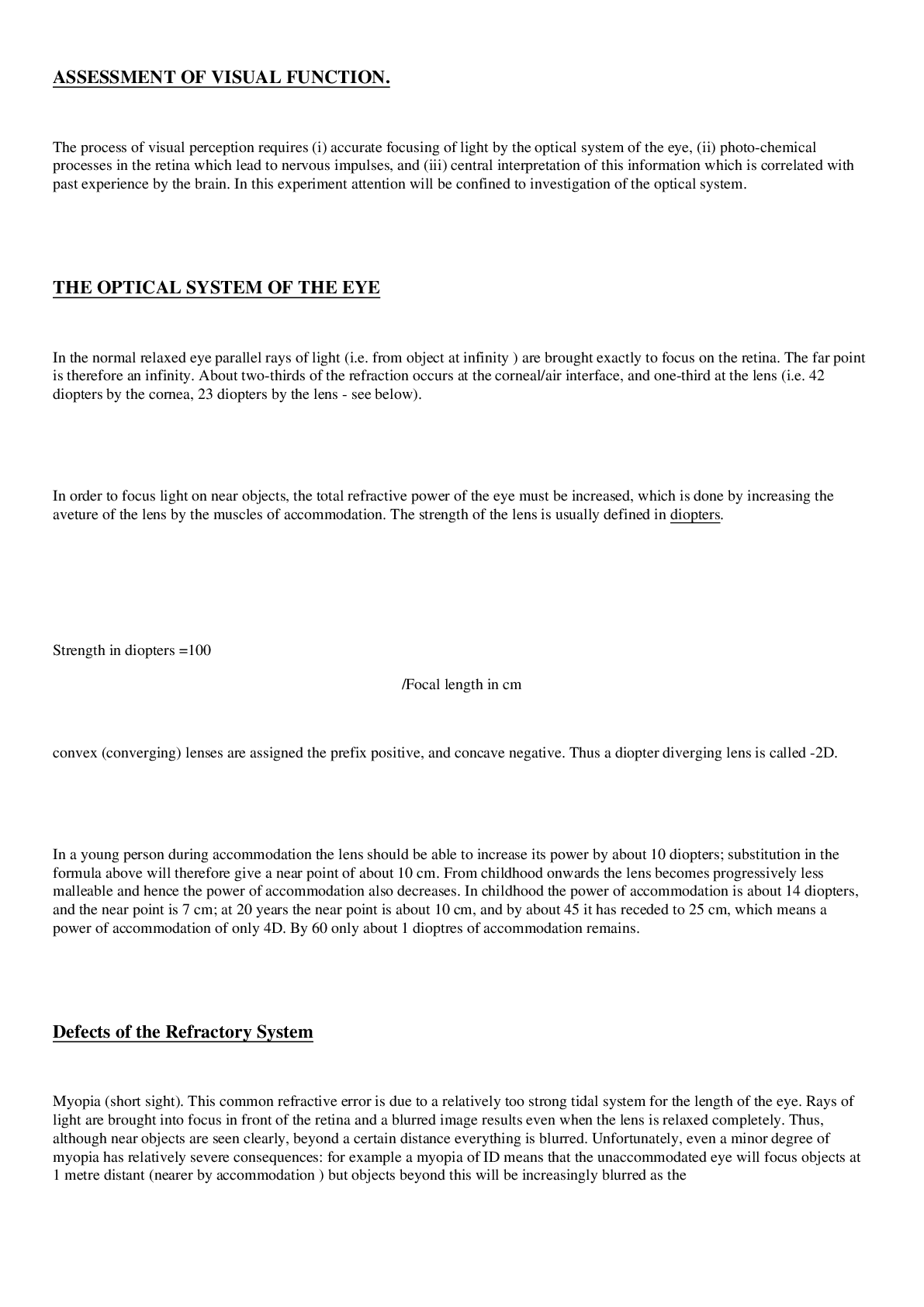Anatomy and Physiology - A&P 1 > GUIDELINES > ASSESSMENT OF VISUAL FUNCTION, STUDY GUIDE. (All)
ASSESSMENT OF VISUAL FUNCTION, STUDY GUIDE.
Document Content and Description Below
ASSESSMENT OF VISUAL FUNCTION. The process of visual perception requires (i) accurate focusing of light by the optical system of the eye, (ii) photo-chemical processes in the retina which lead to n ... ervous impulses, and (iii) central interpretation of this information which is correlated with past experience by the brain. In this experiment attention will be confined to investigation of the optical system. THE OPTICAL SYSTEM OF THE EYE In the normal relaxed eye parallel rays of light (i.e. from object at infinity ) are brought exactly to focus on the retina. The far point is therefore an infinity. About two-thirds of the refraction occurs at the corneal/air interface, and one-third at the lens (i.e. 42 diopters by the cornea, 23 diopters by the lens - see below). In order to focus light on near objects, the total refractive power of the eye must be increased, which is done by increasing the aveture of the lens by the muscles of accommodation. The strength of the lens is usually defined in diopters. Strength in diopters = 100 /Focal length in cm convex (converging) lenses are assigned the prefix positive, and concave negative. Thus a diopter diverging lens is called -2D. In a young person during accommodation the lens should be able to increase its power by about 10 diopters; substitution in the formula above will therefore give a near point of about 10 cm. From childhood onwards the lens becomes progressively less malleable and hence the power of accommodation also decreases. In childhood the power of accommodation is about 14 diopters, and the near point is 7 cm; at 20 years the near point is about 10 cm, and by about 45 it has receded to 25 cm, which means a power of accommodation of only 4D. By 60 only about 1 dioptres of accommodation remains. Defects of the Refractory System 1. Myopia (short sight). This common refractive error is due to a relatively too strong tidal system for the length of the eye. Rays of light are brought into focus in front of the retina and a blurred image results even when the lens is relaxed completely. Thus, although near objects are seen clearly, beyond a certain distance everything is blurred. Unfortunately, even a minor degree of myopia has relatively severe consequences: for example a myopia of ID means that the unaccommodated eye will focus objects at 1 metre distant (nearer by accommodation ) but objects beyond this will be increasingly blurred as the whole range of distances from infinity to 1 metre represents only 1 dioptre. (Apply appropriate figures to lens formula above). 2. Hypermetropia (long sight). Here the eye is too short for the optical system and even with the eye fully accommodated the rays from near objects are brought into focus behind the near point, therefore, is further away than normal. Some accommodation is required even for distant objects. [Show More]
Last updated: 3 years ago
Preview 1 out of 7 pages

Buy this document to get the full access instantly
Instant Download Access after purchase
Buy NowInstant download
We Accept:

Reviews( 0 )
$11.00
Can't find what you want? Try our AI powered Search
Document information
Connected school, study & course
About the document
Uploaded On
Aug 30, 2022
Number of pages
7
Written in
All
Additional information
This document has been written for:
Uploaded
Aug 30, 2022
Downloads
0
Views
110














